In a rapidly modernising world, technology can enhance and enrich the process of dental treatments. Traditional techniques have stood the test of time, and for many dentists, are dependable ways to get results. A successful procedure solidifies the rapport between patient and dentist; the former is left with a healthy smile, and the latter with positive feedback for their practice. Nevertheless, striving for accuracy means diminishing ways that errors could occur during or after a procedure. One of these ways could be equipping your practice with state-of-the-art technology, designed to lessen the time that patients spend in the chair, as well as reducing any prospect of an error occurring.
The importance of accuracy
Errors are always a possibility, and the more intricate the procedure, the higher the risk. While the long-term failure rate for dental implants is only 5-10%,[i] reducing the margin for error is still paramount. For example, on the rare occasion that the implant may be misplaced, nerve and/or tissue damage could be triggered, which may actually cause a decline in the quality of a patient’s life. [ii] Of course, the more experienced the dentist, the less likely issues will occur; in fact, studies have shown that there are connections between clinician training and the success of dental implant treatment.[iii] Therefore, newer generations of dentists need to stay ahead of the game and arm their practices with equipment designed to streamline procedures, and eliminate the margin of error.
Certain errors may also stem from conventional impression taking; the impression material may not capture the true likeness of the teeth and gingiva, perhaps due to the patient fidgeting. Or, more inevitably, the occurrence of moisture in the mouth, which can cause bubbles in the impression. The material itself may not be able to fit in the gaps between the teeth, which causes further inaccuracies. All of this can impact the precision and predictability of the restorative process.
Complexities within restorative treatment can be simplified by using digital equipment, such as intraoral scanners. Intraoral scanners enable dentists to produce impressions more quickly, comfortably, and efficiently. Any issues that may occur with traditional impression taking could be reduced with the use of a digital scanner; where the conventional impression material may not capture every intricacy of the mouth, the digital impression will.
 Misconceptions
Misconceptions
Digital technology can come with what seems to be a hefty price tag. Many dentists may be sceptical about committing to the digital path, but equipment, such as the intraoral scanners, are often a very effective investment. Patients, who are willing to commit the time and money to implant treatment, will want to maximise on their investment. A high standard of service, comfort and skill will be expected throughout the procedure. By encouraging faith and trust in the dentist and their practice, digital equipment will pay for themselves time and time again.
As expected, dentists must become acquainted with new technology. Re-learning procedures with the use of digital solutions may seem an arduous addition to an already hectic work schedule. But investing the time to learn these technologies and software programmes will prove beneficial, as accuracy will be achieved more easily, and thus the margin of error will be reduced. Patients may also be more willing to return to a dental practice if their experience of the procedure, and its results, was positive overall.
Sophisticated solutions from the Straumann Group
Treatments, both simple and complex, have varying likelihoods for potential errors, but it is increasingly important for dentists to ensure that treatment is accurate and efficient for the patient in all scenarios. Investing in the latest digital technology will aid in achieving this. The Straumann Group offers the distinguished 3Shape Trios® intraoral scanner, which makes for an ingenious addition to the digital workflow; scanning is enhanced with the instant-heat feature, meaning you can scan within seconds. The accuracy of these scans is made effortless, as the Trios® scanner creates crisp digital colour impressions, whilst measuring shades of the teeth. Comfort for both patient and dentist is optimised, as scans can be made quickly with no need for uncomfortable impression materials. The scanner blends seamlessly into the digital workflow, upgrading and revolutionising any dental treatment.
Patient comfort and happiness are the ultimate outcomes during and following any dental procedure. With the technology for dental treatments improving rapidly, keeping your practice ahead of the curve is easier now than ever.
For more information on intraoral scanners and digital solutions from the Straumann Group, visit: https://www.straumann.com/digital/en/home/equipment/io-scanners.html
[i] Tabanella, G., H. Nowzari and J. Slots. “Clinical and microbiological determinants of ailing dental implants.” Clinical implant dentistry and related research 11 1 (2009): 24-36.
[ii] Fukuda, K., Ichinohe, T., & Kaneko, Y. (2012). Pain Management for Nerve Injury following Dental Implant Surgery at Tokyo Dental College Hospital. International journal of dentistry, 2012, 209474. https://doi.org/10.1155/2012/209474
[iii] Sonkar, J., Maney, P., Yu, Q. et al. Retrospective study to identify associations between clinician training and dental implant outcome and to compare the use of MATLAB with SAS. Int J Implant Dent 5, 28 (2019). https://doi.org/10.1186/s40729-019-0182-6













 Dr Rubina Fur
Dr Rubina Fur



 Misconceptions
Misconceptions 




